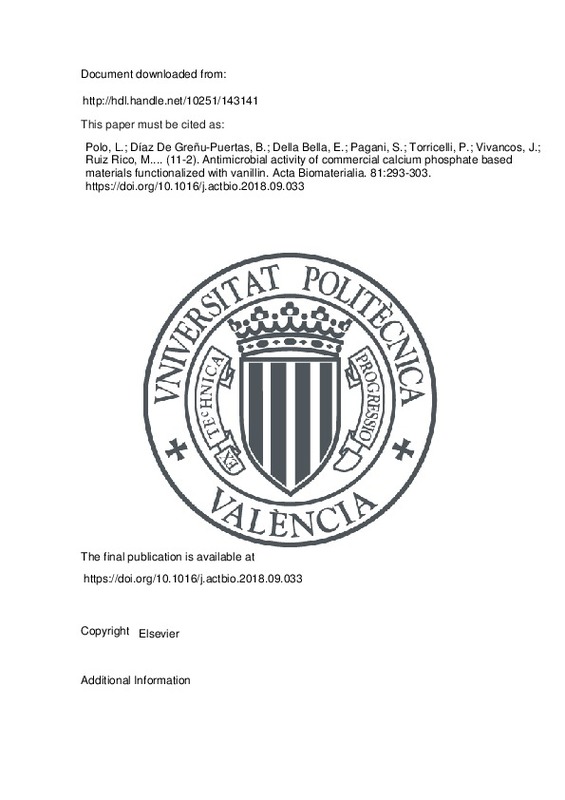Polo, L.; Díaz De Greñu-Puertas, B.; Della Bella, E.; Pagani, S.; Torricelli, P.; Vivancos, J.; Ruiz Rico, M.... (2018). Antimicrobial activity of commercial calcium phosphate based materials functionalized with vanillin. Acta Biomaterialia. 81:293-303. https://doi.org/10.1016/j.actbio.2018.09.033
Por favor, use este identificador para citar o enlazar este ítem: http://hdl.handle.net/10251/143141
|
Título:
|
Antimicrobial activity of commercial calcium phosphate based materials functionalized with vanillin
|
|
Autor:
|
Polo, Lorena
Díaz de Greñu-Puertas, Borja
Della Bella, Elena
Pagani, Stefania
Torricelli, Paola

 Vivancos, José-Luis
Vivancos, José-Luis

 Ruiz Rico, María
Ruiz Rico, María

 Barat Baviera, José Manuel
Barat Baviera, José Manuel

 Aznar, Elena
Aznar, Elena

 Martínez-Máñez, Ramón
Fini, Milena
Martínez-Máñez, Ramón
Fini, Milena

 Sancenón Galarza, Félix
Sancenón Galarza, Félix
|
|
Entidad UPV:
|
Universitat Politècnica de València. Departamento de Química - Departament de Química
Universitat Politècnica de València. Departamento de Proyectos de Ingeniería - Departament de Projectes d'Enginyeria
Universitat Politècnica de València. Departamento de Ingeniería Mecánica y de Materiales - Departament d'Enginyeria Mecànica i de Materials
Universitat Politècnica de València. Departamento de Tecnología de Alimentos - Departament de Tecnologia d'Aliments
|
|
Fecha difusión:
|
|
|
Resumen:
|
[EN] Infections represent one of the most frequent causes of arthroplasty revision. Thus, design of new antimi-crobial scaffolds to reduce implant rejections, bone infections and associated medical costs is highlydesired. ...[+]
[EN] Infections represent one of the most frequent causes of arthroplasty revision. Thus, design of new antimi-crobial scaffolds to reduce implant rejections, bone infections and associated medical costs is highlydesired. In recent years, essential oil components (EOCs) have merged as compounds with signi¿cantantimicrobial activity that can be attached to speci¿c surfaces to enhance and prolong their antimicrobialeffect. Herein calcium phosphate CaP regenerative materials have been coated with a vanillin derivativeto combine its original bone regeneration properties with antimicrobial action of EOCs. Materials in formof microparticles and blocks were prepared and fully characterized. Clonogenic viability tests demon-strated that low concentrations of material (10 mg/mL-1) resulted effective to kill 100% of E. coli DH5abacteria. Additionally, vanillin containing scaffolds did not display any toxic effect over cells, yet theypreserve the ability to express alkaline phosphatase (ALPL), collagen type 1, chaina1(COL1A1) and bonegamma-carboxyglutamic acid-containing protein or osteocalcin (BGLAP), which are genes typicallyexpressed by osteoblasts. These results demonstrate that commercially available scaffolds can be func-tionalized with EOCs, achieving antimicrobial activity and open up a new approach for the treatmentand prevention of infection.
[-]
|
|
Palabras clave:
|
Biomaterials
,
Antimicrobial
,
Essential oils
,
Vanillin
|
|
Derechos de uso:
|
Reconocimiento - No comercial - Sin obra derivada (by-nc-nd)
|
|
Fuente:
|
Acta Biomaterialia. (issn:
1742-7061
)
|
|
DOI:
|
10.1016/j.actbio.2018.09.033
|
|
Editorial:
|
Elsevier
|
|
Versión del editor:
|
https://doi.org/10.1016/j.actbio.2018.09.033
|
|
Código del Proyecto:
|
info:eu-repo/grantAgreement/IOR//6879/
info:eu-repo/grantAgreement/GVA//PROMETEOII%2F2014%2F047/ES/Nuevas aproximaciones para el diseño de materiales de liberación controlada y la detección de compuestos peligrosos/
info:eu-repo/grantAgreement/MINECO//MAT2015-64139-C4-1-R/ES/NANOMATERIALES INTELIGENTES, SONDAS Y DISPOSITIVOS PARA EL DESARROLLO INTEGRADO DE NUEVAS HERRAMIENTAS APLICADAS AL CAMPO BIOMEDICO/
|
|
Agradecimientos:
|
The authors thank the Spanish Government, Spain for projects MAT2015-64139-C04-01-R (MINECO/FEDER). Also, Generalitat Valenciana, Spain (project PROMETEOII/2014/047) is acknowledged for their support. L. P. thanks Universitat ...[+]
The authors thank the Spanish Government, Spain for projects MAT2015-64139-C04-01-R (MINECO/FEDER). Also, Generalitat Valenciana, Spain (project PROMETEOII/2014/047) is acknowledged for their support. L. P. thanks Universitat Politecnica de Valencia, Spain for her FPI and mobility grants. B.D. thanks to Ministerio de Economia, Ciencia y Competitividad, Spain for his Juan de la Cierva-Formation fellowship. The authors also thank the Electron Microscopy Service at the UPV for their support. The authors are grateful to IRCCS Rizzoli Orthopaedic Institute, Italy (funds 5 X 1000 year 2015, cod. 6879).
[-]
|
|
Tipo:
|
Artículo
|







![[Cerrado]](/themes/UPV/images/candado.png)


